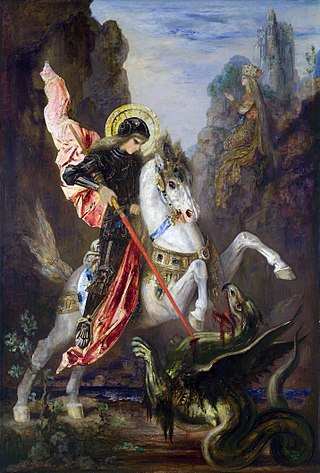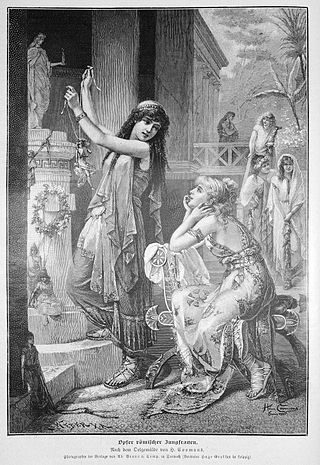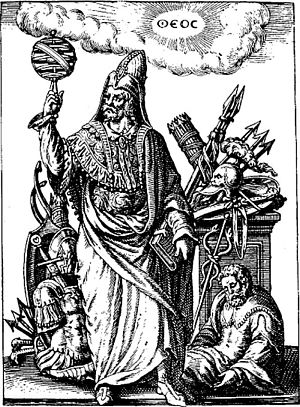
Christian mythology is the body of myths associated with Christianity. The term encompasses a broad variety of legends and narratives, especially those considered sacred narratives. Mythological themes and elements occur throughout Christian literature, including recurring myths such as ascending a mountain, the axis mundi, myths of combat, descent into the Underworld, accounts of a dying-and-rising god, a flood myth, stories about the founding of a tribe or city, and myths about great heroes of the past, paradises, and self-sacrifice.

Paganism is a term first used in the fourth century by early Christians for people in the Roman Empire who practiced polytheism, or ethnic religions other than Judaism. In the time of the Roman Empire, individuals fell into the pagan class either because they were increasingly rural and provincial relative to the Christian population, or because they were not milites Christi. Alternative terms used in Christian texts were hellene, gentile, and heathen. Ritual sacrifice was an integral part of ancient Graeco-Roman religion and was regarded as an indication of whether a person was pagan or Christian. Paganism has broadly connoted the "religion of the peasantry".
Religion and mythology differ in scope but have overlapping aspects. Both are systems of concepts that are of high importance to a certain community, making statements concerning the supernatural or sacred. Generally, mythology is considered one component or aspect of religion. Religion is the broader term: besides mythological aspects, it includes aspects of ritual, morality, theology, and mystical experience. A given mythology is almost always associated with a certain religion such as Greek mythology with Ancient Greek religion. Disconnected from its religious system, a myth may lose its immediate relevance to the community and evolve—away from sacred importance—into a legend or folktale.

Amanita muscaria, commonly known as the fly agaric or fly amanita, is a basidiomycete of the genus Amanita. Native throughout the temperate and boreal regions of the Northern Hemisphere, Amanita muscaria has been unintentionally introduced to many countries in the Southern Hemisphere, generally as a symbiont with pine and birch plantations, and is now a true cosmopolitan species. It associates with various deciduous and coniferous trees.
Christian views on magic vary widely among Christian denominations and among individuals. Many Christians actively condemn magic as satanic, holding that it opens the way for demonic possession. Some Christians simply view it as entertainment. Conversely, some branches of esoteric Christianity actively engage in magical practices.

The genus Amanita contains about 600 species of agarics, including some of the most toxic known mushrooms found worldwide, as well as some well-regarded edible species. The genus is responsible for approximately 95% of fatalities resulting from mushroom poisoning, with the death cap accounting for about 50% on its own. The most potent toxin present in these mushrooms is α-Amanitin.

Entheogens are psychoactive substances that induce alterations in perception, mood, consciousness, cognition, or behavior for the purposes of engendering spiritual development or otherwise in sacred contexts. Anthropological studies have established that entheogens are used for religious, magical, shamanic, or spiritual purposes in many parts of the world. Entheogens have traditionally been used to supplement many diverse practices geared towards achieving transcendence, including divination, meditation, yoga, sensory deprivation, healings, asceticism, prayer, trance, rituals, chanting, imitation of sounds, hymns like peyote songs, drumming, and ecstatic dance. The psychedelic experience is often compared to non-ordinary forms of consciousness such as those experienced in meditation, near-death experiences, and mystical experiences. Ego dissolution is often described as a key feature of the psychedelic experience.

Religious practices in ancient Greece encompassed a collection of beliefs, rituals, and mythology, in the form of both popular public religion and cult practices. The application of the modern concept of "religion" to ancient cultures has been questioned as anachronistic. The ancient Greeks did not have a word for 'religion' in the modern sense. Likewise, no Greek writer known to us classifies either the gods or the cult practices into separate 'religions'. Instead, for example, Herodotus speaks of the Hellenes as having "common shrines of the gods and sacrifices, and the same kinds of customs."

Forbidden fruit is a name given to the fruit growing in the Garden of Eden which God commands mankind not to eat. In the biblical story, Adam and Eve eat the fruit from the tree of the knowledge of good and evil and are exiled from Eden:
And the Lord God commanded the man, saying, Of every tree of the garden thou mayest freely eat:
But of the tree of the knowledge of good and evil, thou shalt not eat of it: for in the day that thou eatest thereof thou shalt surely die.

Sacred mysteries are the areas of supernatural phenomena associated with a divinity or a religious belief and praxis. Sacred mysteries may be either:
- Religious beliefs, rituals or practices which are kept secret from the uninitiated.
- Beliefs of the religion which are public knowledge but cannot be easily explained by normal rational or scientific means.

Esoteric Christianity is an approach to Christianity which features "secret traditions" that require an initiation to learn or understand. The term esoteric was coined in the 17th century and derives from the Greek ἐσωτερικός.
Carl A. P. Ruck, is a professor in the Classical Studies department at Boston University. He received his B.A. at Yale University, his M.A. at the University of Michigan, and a Ph.D. at Harvard University. He lives in Hull, Massachusetts.

Ethnomycology is the study of the historical uses and sociological impact of fungi and can be considered a subfield of ethnobotany or ethnobiology. Although in theory the term includes fungi used for such purposes as tinder, medicine and food, it is often used in the context of the study of psychoactive mushrooms such as psilocybin mushrooms, the Amanita muscaria mushroom, and the ergot fungus.
(Blaise) Daniel "Danny" Staples was a Classical mythologist; a native of Somerset, Massachusetts, he received a B.A. in Comparative Religion and a Ph.D. in Classical Studies from Boston University. He lived in Hull, Massachusetts with his spouse, Carl A.P. Ruck.

Hermetic Qabalah is a Western esoteric tradition involving mysticism and the occult. It is the underlying philosophy and framework for magical societies such as the Golden Dawn, Thelemic orders, mystical-religious societies such as the Builders of the Adytum and the Fellowship of the Rosy Cross, and is a precursor to the Neopagan, Wiccan and New Age movements. The Hermetic Qabalah is the basis for Qliphothic Qabala as studied by left-hand path orders, such as the Typhonian Order.

Apples appear in many religious traditions, often as a mystical or forbidden fruit. One of the problems identifying apples in religion, mythology and folktales is that as late as the 17th century, the word "apple" was used as a generic term for all (foreign) fruit other than berries, but including nuts. This term may even have extended to plant galls, as they were thought to be of plant origin. For instance, when tomatoes were introduced into Europe, they were called "love apples". In one Old English work, cucumbers are called eorþæppla, just as in French, Dutch, Hebrew, Afrikaans, Persian and Swiss German as well as several other German dialects, the words for potatoes mean "earth-apples". In some languages, oranges are called "golden apples" or "Chinese apples". Datura is called "thorn-apple".

Jewish mythology is the body of myths associated with Judaism. Elements of Jewish mythology have had a profound influence on Christian mythology and on Islamic mythology, as well as on Abrahamic culture in general. Christian mythology directly inherited many of the narratives from the Jewish people, sharing in common the narratives from the Old Testament. Islamic mythology also shares many of the same stories; for instance, a creation-account spaced out over six periods, the legend of Abraham, the stories of Moses and the Israelites, and many more.

Amanita regalis, commonly known as the royal fly agaric or the king of Sweden Amanita, is a species of fungus in the family Amanitaceae. Common in Scandinavian countries, it is also found in eastern and northern Europe. In North America, its distribution is restricted to Alaska. The fruit bodies of the fungus somewhat resemble the fly agaric, and it was formerly regarded as a variety of this species. A. regalis differs from it in being larger, with a liver-brown cap bearing numerous scabs, and in having a stem which is yellow-ochre at the base, with patches or rings of patches. Chemical analysis has shown that this species contains muscimol, the same psychoactive compound found in A. muscaria.

The Sacred Mushroom and the Cross: A Study of the Nature and Origins of Christianity Within the Fertility Cults of the Ancient Near East is a 1970 book about the linguistics of early Christianity and fertility cults in the Ancient Near East. It was written by John Marco Allegro (1923–1988).

Mushrooms have been found in art traditions around the world, including in western and non-western works. Ranging throughout those cultures, works of art that depict mushrooms can be found in ancient and contemporary times. Often, symbolic associations can also be given to the mushrooms depicted in the works of art. For instance, in Mayan culture, mushroom stones have been found that depict faces in a dreamlike or trance-like expression, which could signify the importance of mushrooms giving hallucinations or trances. Another example of mushrooms in Mayan culture deals with their codices, some of which might have depicted hallucinogenic mushrooms. Other examples of mushroom usage in art from various cultures include the Pegtymel petroglyphs of Russia and Japanese Netsuke figurines.















